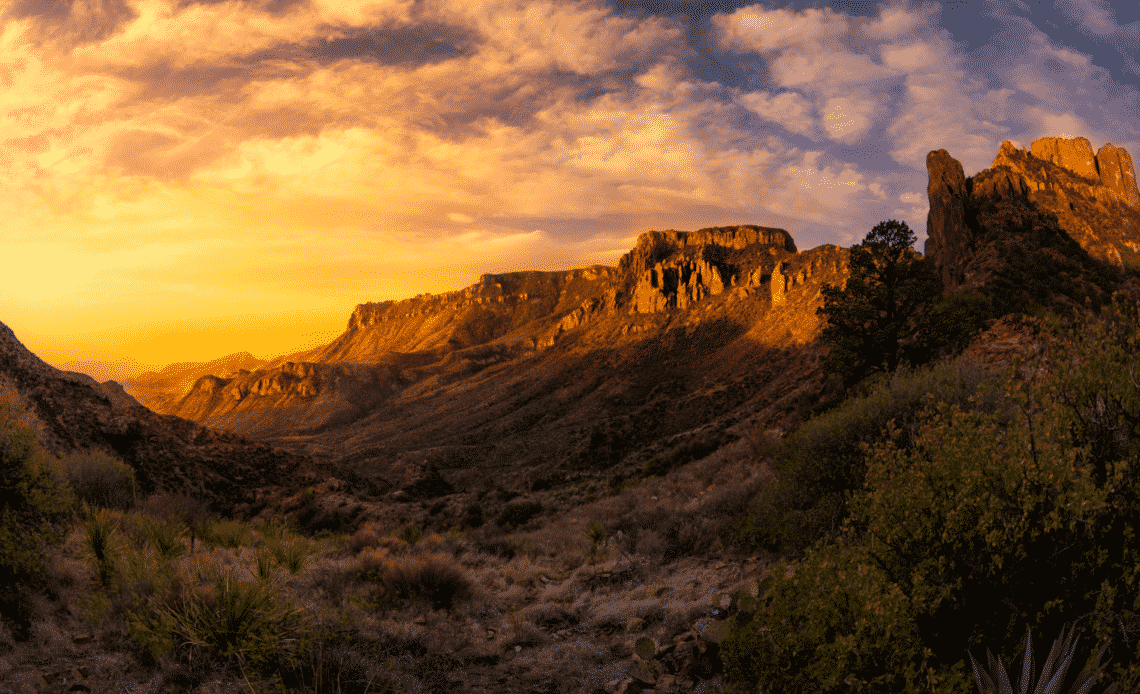
Awe Inspiring National Parks to Visit This Spring – Part II
This is a 3-part series describing road trip itineraries to 9 beautiful and unique US National Parks.
Part 2: Big Bend National Park, Guadalupe Mountains National Park, Carlsbad Caverns National Park, and White Sands National Park
Looking for an epic road trip to four stunning southwestern national parks that you need to visit now? You’ve come to the right place.
In this second of our three-part series on national parks to visit this spring, we head to Texas and New Mexico.
In this article, you’ll find the best road trip itinerary for visiting Big Bend, Guadalupe Mountains, Carlsbad Caverns, and White Sands National Parks.
The US national parks make great destinations for both families and solo travelers with their gorgeous scenery and exciting outdoor opportunities.
And what better way to experience the national parks than with a road trip?

To help you plan the best trip ever, I’ve put together an awesome 5 to 6 day road trip itinerary to these four often overlooked national parks.
I’ve also included things to do, places to stay, and tips on getting to the parks and making the most out of your visit.
Spring is a GREAT time for a road trip to visit these national parks in particular for the more favorable temperatures and weather conditions.
So if you’re not into crowds or sweltering heat, I highly recommend visiting these parks in April or May.
This post may contain affiliate links, which means I’ll receive a small commission if you purchase through my links, at no extra cost to you. Please read my full disclosure for more information. Thank you for supporting my blog!
Big Bend National Park
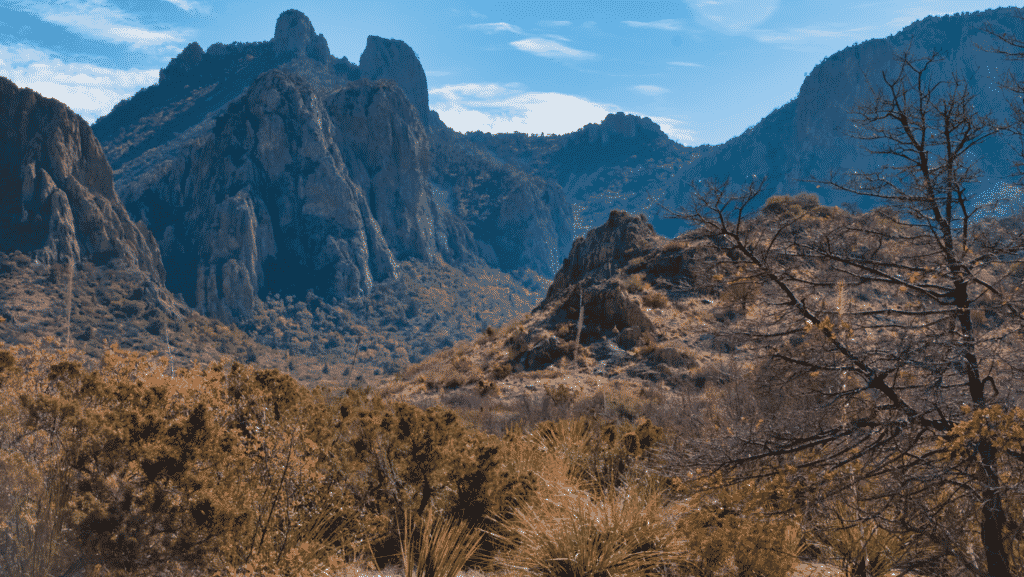
Located in southwest Texas, Big Bend National Park contains the Chisos Mountains, the Chihuahuan Desert, and is bordered in part by the Rio Grande River.
In fact, Big Bend National Park got its name from a large bend in the Rio Grande River that runs through the park. The river serves not only as the park boundary but an international boundary with Mexico as well.
The park encompasses more than 800,000 acres (or 1250 sq. miles), making it larger than the state of Rhode Island.
The park’s main visitor center is located at Panther Junction where you’ll find exhibits, a bookstore, souvenir shop, US Post Office, restrooms, and you can pay entrance and permit fees here as well.
Interesting fact: Big Bend National Park is the only national park that contains an entire mountain range (the Chisos Mountains) within its borders. (Good to know for those family night trivia games.)
Getting there
The closest airport to Big Bend National Park is in Midland, TX and is roughly a 3 hour drive to the park. From El Paso, the park is a 4.5 hours away, and from San Antonio it’s about 5.5 hours.
If it’s convenient for you to do so, consider flying into one of these cities and renting a car to get you to the national park. You can check car rental rates here.
Of course if you prefer, you can always drive your way through Texas and add to your trip with other stops along the way.
If you want to know what you should bring on a road trip, check out my list of 25 Road Trip Essentials.
Where to stay
However you choose to arrive at Big Bend National Park, you have some options for accommodations.
There are several campgrounds within the park as well as wilderness camping available.
There’s also several other unique options as well.
Camping – November thru April is peak season and the park’s three campgrounds, RV park, and backcountry sites are full to capacity every night.
Reservations are required and if you visit in late April or May, you may find it easier to get a reservation.
If you prefer to camp, I would make sure that you reserve your stay months in advance.
Chisos Mountains Lodge – Located at Chisos Basin Visitor Center, the Lodge has basic motel type rooms that are supplied with a fridge and microwave.
While the rooms are basic, guests rave about the service and how pleasant and helpful they found the staff.
The Lodge is very rustic but the views are incredible.
TIP: I recommend you bring food with you in case you find yourself hungry after the restaurant closes for the evening.
Ten Bits Ranch – One of the most popular options is located about 20 minutes north of Big Bend National Park in Terlingua.
The ranch features Old West themed rooms and since the ranch is powered only by solar, the whole place is entirely off grid making viewing the night sky an epic experience.
The Gage Hotel – Located in Marathon, TX, the hotel is about 42 miles from the north entrance of the park. The hotel also has a wellness spa and gorgeous upscale accommodations to enjoy when you’re not exploring the parks.
DAY 1
Start your day at Panther Junction Visitor Center where you can check out the exhibits, get the latest park updates and obtain a park map.
Chisos Basin Road
Then take the Chisos Basin Road scenic drive and enjoy the spectacular views of the Chisos Mountains.
This stunning drive is just under 10 miles long (20 minutes) and starts in the desert and ends in high alpine where you just might see bears!
At the Chisos Basin Visitor Center, you’ll find the Chisos Mountain Lodge and the Mountain View restaurant, the only restaurant in the park.
You’ll also find several hiking trails in this area including the famous Window Trail and the Lost Mine Trail. (See map above for details.)
Unless you wish to spend the rest of your day hiking the Chisos Mountains (and who wouldn’t?), I recommend returning to Panther Junction where you can then take Rio Grande Village Drive south to Park Route 12 towards the Rio Grande Village.
Rio Grande Village
This scenic drive is spectacular, especially as it drops nearly 2000 feet in elevation in just 20 miles!
Drive time is about 30 minutes (non-stop) but I encourage you to pull over and enjoy the area and the views.
Towards the end of the drive, you’ll find the Historic Hot Springs if you want to experience the warm waters, or take the short trail into Boquillas Canyon for a not-to-be-missed view of the Rio Grande River as it cuts through the canyon.
End the day with a sunset picnic or a relaxing evening at your accommodations nearby.
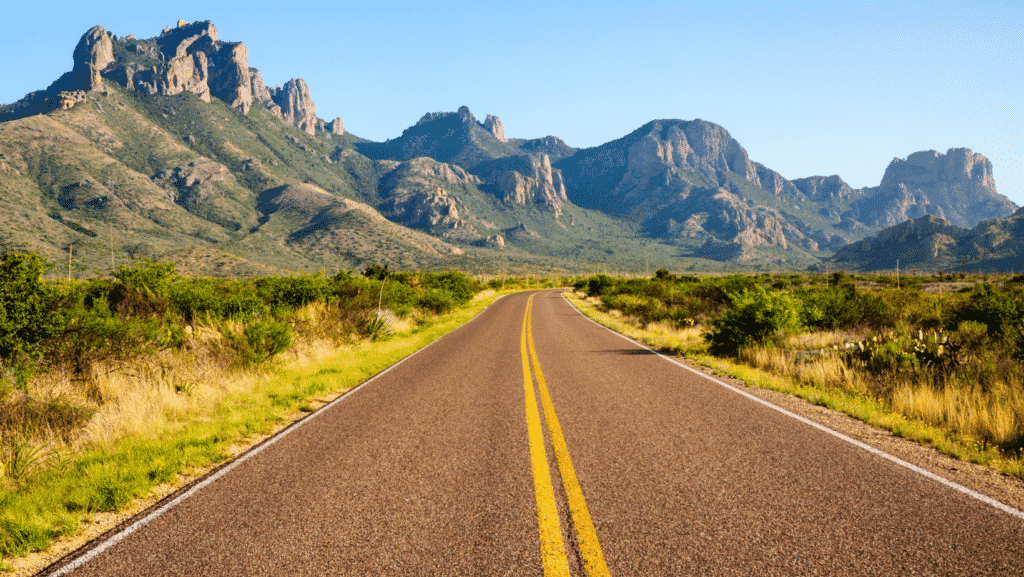
DAY 2
Big Bend National Park has too many beautiful areas to visit and explore to just spend one day here.
If your time allows, I recommend spending at least two days where you can experience the mountains and the river as well as the desert areas that make up Big Bend.
Ross Maxwell Scenic Drive
For the second day in the park, consider taking the Ross Maxwell Scenic Drive from Panther Junction Road to Santa Elena Canyon.
For 31 miles, you’ll experience beautiful views of Chihuahuan Desert on your way to the mouth of the Santa Elena Canyon.
If you choose not to stop anywhere along the way, the drive is just over an hour. But you won’t be able to resist stopping to take in the amazing sights you’ll encounter on this drive!
There are several overlook areas you’ll want to stop at to enjoy the view including Mule Ears Overlook and Tuff Canyon.
You’ll also find several interesting places to explore such as the Sam Nail Ranch and the Castolon Historic Compound which has a visitor center and a store.
After exploring to your heart’s content (or the road beckons you), continue your journey to the Santa Elena Canyon.
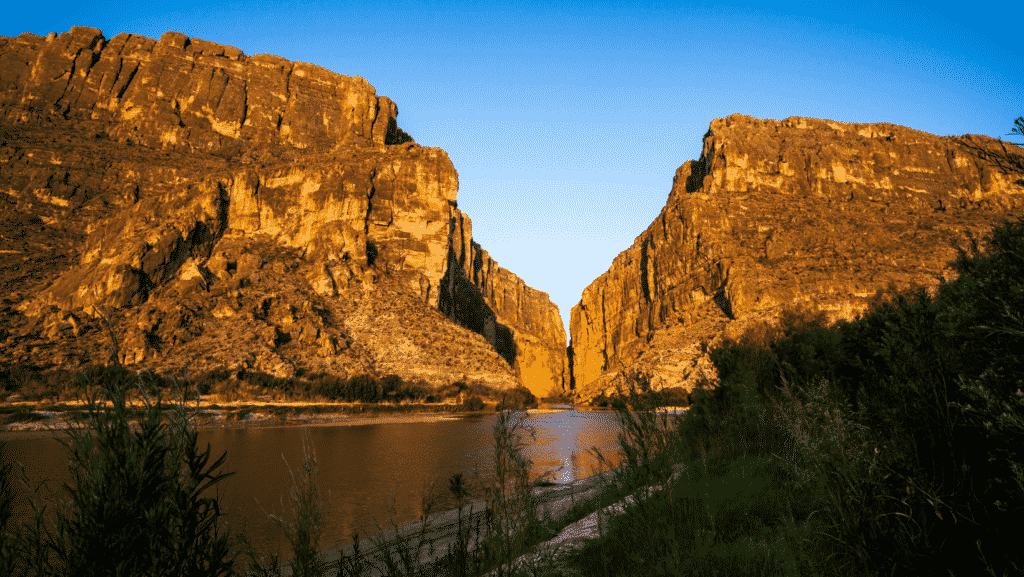
Santa Elena Canyon
The Rio Grande River runs through the middle of the Santa Elena Canyon and is very popular with visitors exploring the canyon by raft, kayak or canoe.
You can view the canyon from the overlook, or hike the 1.4 mile roundtrip trail that leads you into the mouth of the canyon.
Inside the canyon, you’ll find 1500 ft cliffs extending straight up from the river that will take your breath away.
Enjoy the views of the Rio Grande, Santa Elena Canyon, and of course the incredible scenery along the Ross Maxwell Scenic Drive.
Bring a picnic lunch or dinner with you and take in the raw beauty of this often overlooked national park.
Guadalupe Mountains National Park
The next stunning southwestern national park to visit now is the Guadalupe Mountains National Park.
The park is just over 86,000 acres and is located just south of the New Mexico state line
Guadalupe Mountains National Park contains the highest point in Texas, Guadalupe Peak (8,751 feet above sea level).
El Capitan is another recognizable feature found in the park.
Who could miss the 1,000 foot limestone cliff that rises above the Chihuahuan Desert floor?
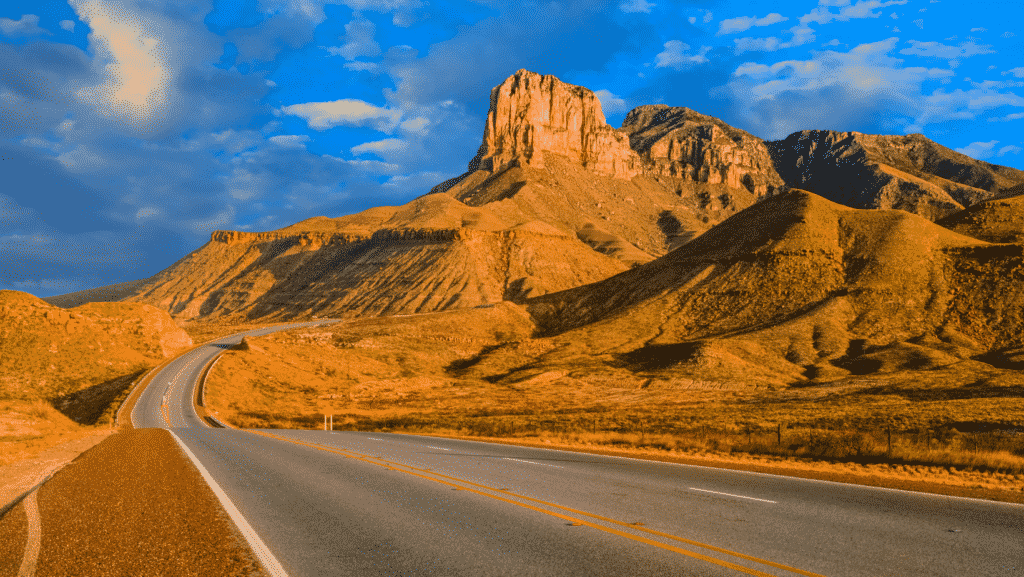
GETTING THERE
Guadalupe Mountains National Park is a hiker’s and backpacker’s dream as there are no roads that pass directly through the park.
Most of the park is only accessible by foot or horseback.
From Big Bend National Park, it’s about a 4.5 hour drive to reach Guadalupe Mountains National Park.
Depending how early a start you get from Big Bend, you could reach Guadalupe Mountains in the early afternoon and have several hours of daylight to explore.
If not, I recommend heading to your accommodations and getting an early start the next morning.
US Hwy 62/180 is the primary road into the park for travelers approaching from the east and brings you near the Pine Springs Visitor Center, accessible via a side road.
You can also take TX St Hwy 54 from Van Horn, TX and enter the park from the south.
Pine Springs Visitor Center is the main visitor center for the park and is the only visitor center with regular hours and rangers readily available to assist you.
There, you can tour the museum, visit the park store, pay entrance and camping fees as well as overnight wilderness use permits.
There are also visitor/ranger stations at Dog Canyon and McKittrick Canyon, but staffing hours vary and rangers may be in the area but not necessarily inside the centers.
TIP: Guadalupe Mountains National Park is in mountain time zone, but cell towers that are accessible from within the park are located in central time zone -so be aware of potential time discrepancies.
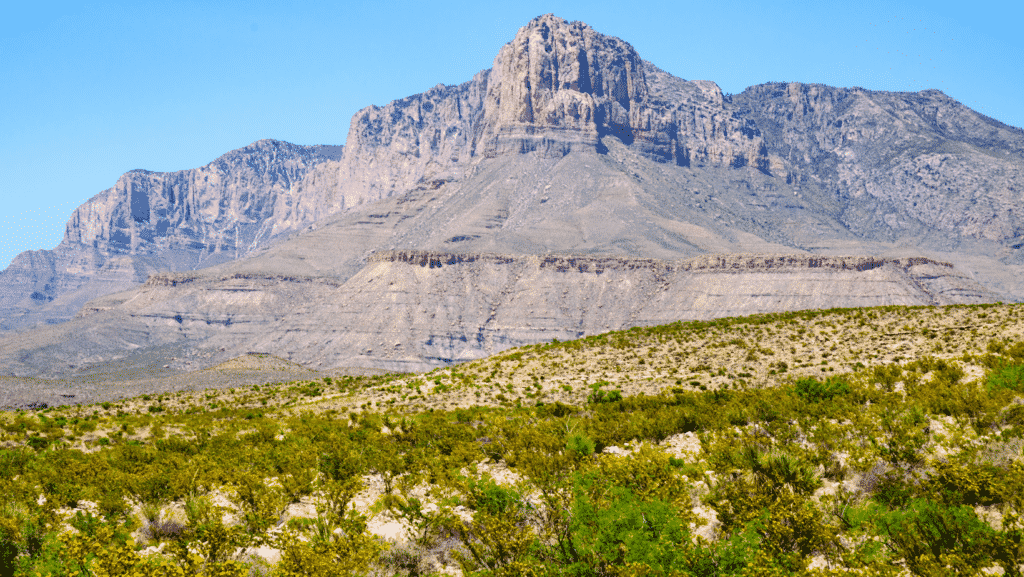
TIP: It’s also worth noting that there is no restaurant in the park. Make sure to bring food and water with you.
Where to stay
Camping – There are three campgrounds inside the park: Pine Springs Campground, Dog Canyon Campground and Frijole Horse Corral Campground
Each campground is accessible by vehicle and requires a reservation. You can make campground reservations here.
There are also ten wilderness campgrounds including Guadalupe Peak Wilderness Campground located about a mile below Guadalupe peak.
These all require a wilderness use permit, which can be purchased at the Pine Springs Visitor Center.
If you’re not camping, I recommend staying in Carlsbad, New Mexico.
Carlsbad, New Mexico
Carlsbad is about a 45 minutes drive from Guadalupe Mountains National Park and is 35 minutes from Carlsbad Caverns National Park – the next stop on our itinerary.
Staying in Carlsbad, NM is a convenient location for visiting both parks and they have a variety of accommodations.
There are several budget hotels including Hampton Inn & Suites Carlsbad, Comfort Suites, and Mainstay Suites to name a few.
For a special treat, consider a local bed & breakfast, the Fiddler’s Inn in Carlsbad. Their six rooms are designed with different themes and there are bbq grills and a picnic area as well.
Van Horn, Texas
If you choose to stay in Van Horn, TX, check out the Hotel El Capitan. They have a free continental breakfast and restaurant as well as a bar/lounge area.
The Holiday Inn Express & Suites is also a popular choice.
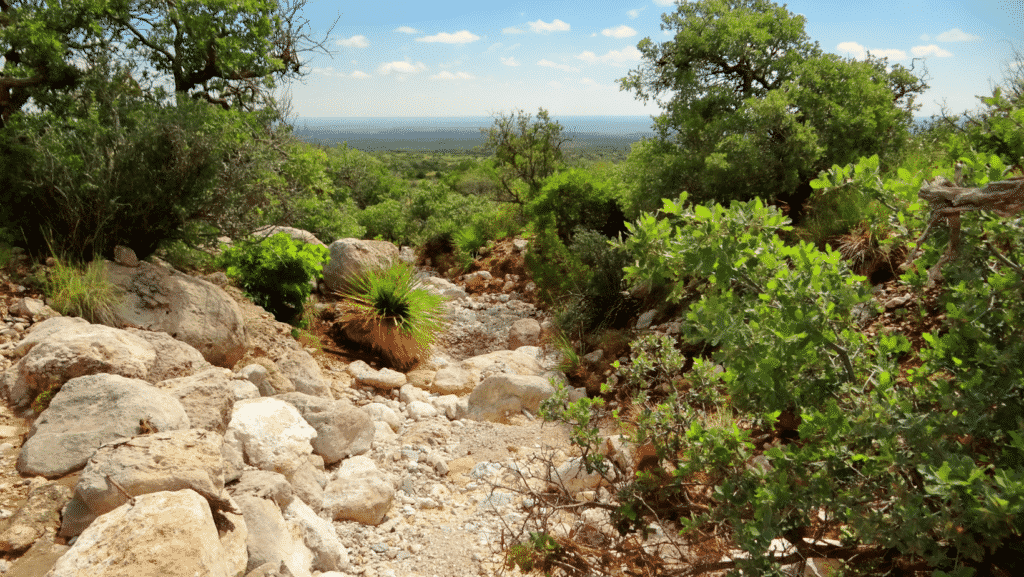
DAY 3 or 4
Unless you plan to hike or backpack, your options of experiencing Guadalupe National Park are limited. The area is truly beautiful though so don’t pass it by.
I recommend beginning your day by driving to McKittrick Canyon. Accessed from Hwy 62/180, take McKittrick Road to the northwest.
The area is day-use only and the gate is only open from 8am-6pm April-October. If you’re visiting in November thru March, the gate closes at 4:30pm.
Here in McKittrick Canyon, you’ll experience what some refer to as “the most beautiful spot in Texas”. Especially in the fall when the foliage is vibrant and dramatic.
Several hiking trails begin at the McKittrick Canyon Trailhead. If you’re interested in exploring these, check out your options here.
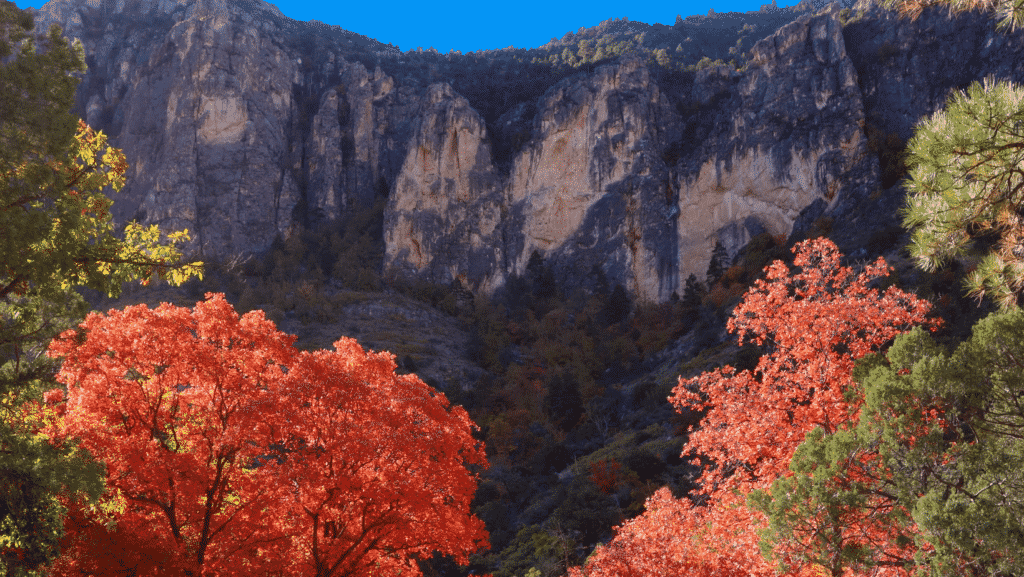
McKittrick Canyon to Salt Flat Scenic Drive
Upon leaving the canyon, I recommend taking the scenic drive from McKittrick Canyon to Salt Flat. Once you’re back on US-62/180 from McKittrick Canyon, it’s just 27 miles until you arrive in Salt Flat.
Along the way, stop to visit the Pine Springs Visitor Center and walk the Pinery Trail. It’s a mile walk on a paved path to view the Old Butterfield stagecoach route.
During the walk, you’ll come up on the ruins of the Pinery Station. Built in 1858 and used for only one year, the ruins are now listed on the National Register of Historic Places.
Once you’ve explored Pine Springs, continue along the scenic drive.
Take your time and appreciate the beautiful scenery along the way.
Guadalupe Peak will be to the northwest and you’ll be able to view the dramatic peak of El Capitan as well.
The next stop on our itinerary is New Mexico and Carlsbad Caverns National Park.
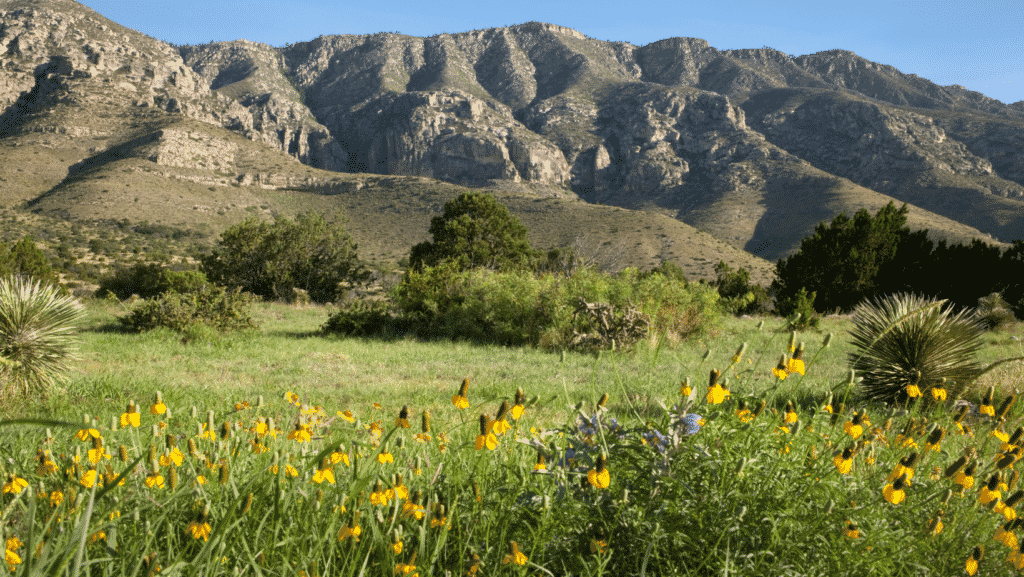
Carlsbad Caverns National Park
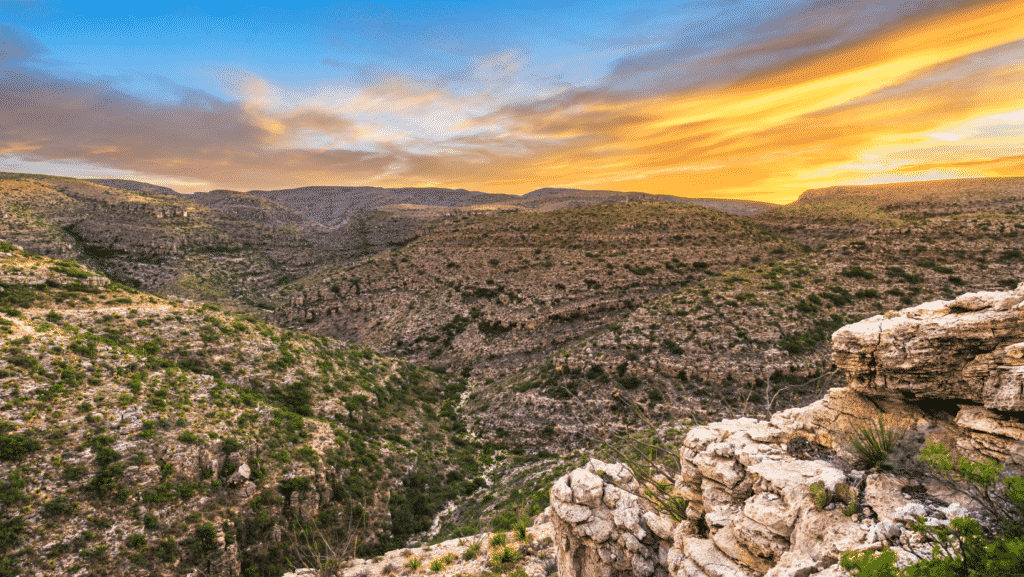
For the next stunning southwestern national park to visit we head to New Mexico.
From Pine Springs Visitor Center in Guadalupe Mountain National Park, the Carlsbad Cavern Visitor Center is about a 45 minute drive.
If you choose to, it is possible to visit both Guadalupe Mountains National Park and Carlsbad Caverns in the same day.
But why rush through these stunning southwestern national parks and miss the experience of discovering what makes them unique?
However, I realize that sometimes we are limited on time so if that’s the case, just know it is possible.
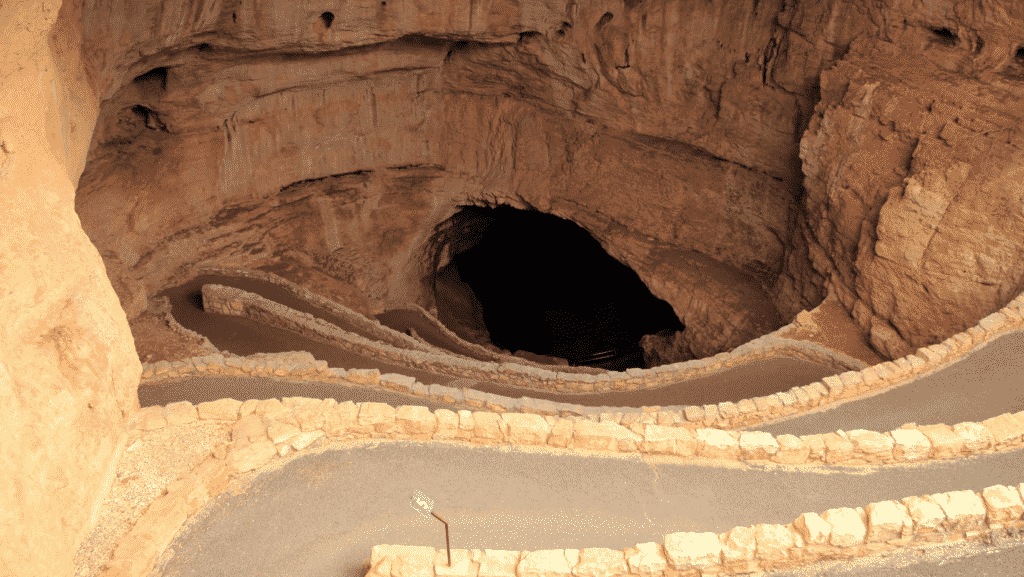
GETTING THERE
From Whites City, NM (off Hwy 62/180) turn north onto Carlsbad Cavern Highway (NM Hwy 7).
It’s a 7 mile drive from Whites City (and the park gate) to the visitor center where you’ll find the entrance to the cavern.
From the town of Carlsbad, the caverns are less than 30 miles down Hwy 180.
Where to stay
There are no lodging or campgrounds located in Carlsbad Caverns National Park.
Primitive camping is allowed with a free permit obtained upon your arrival at the visitor center.
If you’re camping, the closest campground to the caverns is in Whites City.
Otherwise I recommend staying in Carlsbad at one of the locations mentioned above: Hampton Inn & Suites Carlsbad, Comfort Suites, Mainstay Suites or the Fiddler’s Inn.
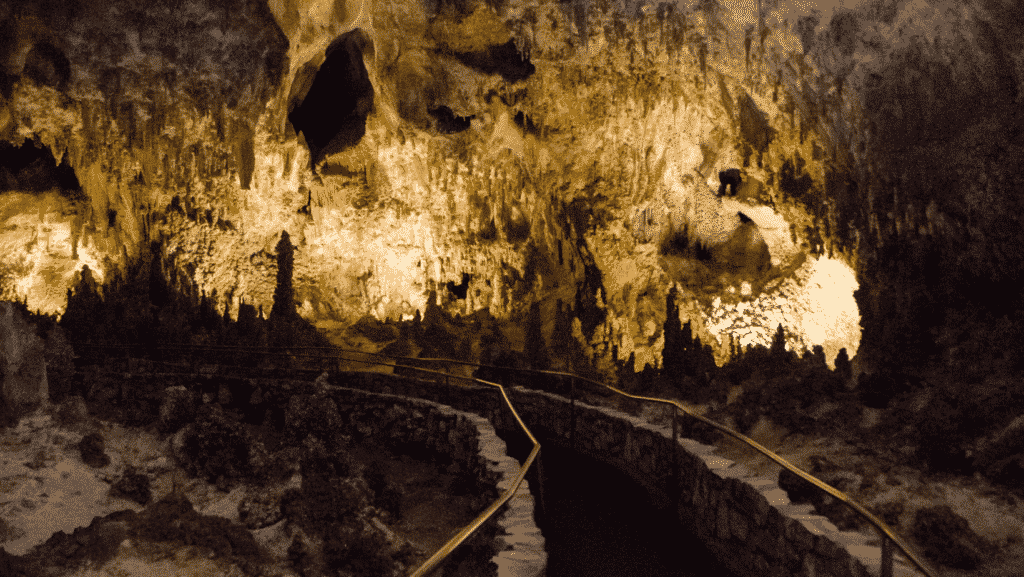
DAY 5
Carlsbad Caverns
Visit the cavern. At this time, reservations are required to enter the cavern and must be obtained online prior to entering the park.
The national park fee for the caverns is paid at the visitor center. Read about the entrance fees and reservations here.
Once at the caverns, you have two options.
You may take the walking trail from the natural entrance to the cavern – it’s about 1.25 miles and very steep. Or, take the elevator down into the caverns from inside the visitor center.
Once you’re in the caverns enjoy the self-guided tour.
TIP: Rent an audio guide from the bookshop as there are no ranger-led tours currently being offered.
Most people take about an hour and explore the notable formations including Devil’s Spring, Iceberg Rock, and Whale’s Mouth.
You can also take the Big Room Trail, which is 1.5 miles long and fairly flat. On this trail you’ll get to see the largest single cave chamber in North America (by volume).
TIP: Wear closed toe shoes with good traction as cavern floors may be damp and slippery. Also consider bringing a jacket as the air temp inside the cavern is 56ºF and a headlamp for extra visibility.
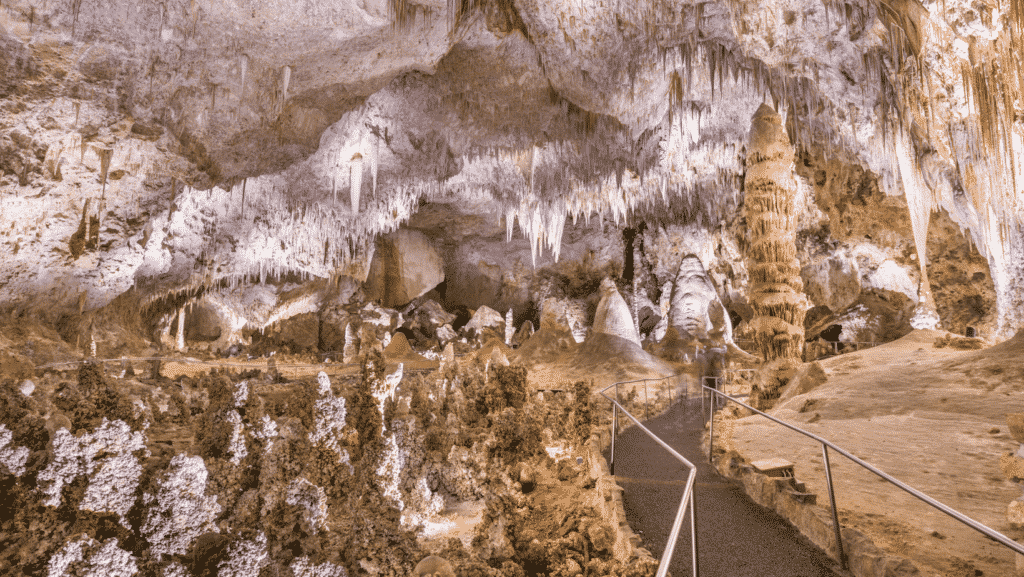
If you have the ability and the opportunity, consider taking the entrance trail down into the cavern so as not to miss the stunning formation.
Then once you’re ready to leave, take the elevator back to the surface.
This allows you to see more of the caverns without the strenuous hike back to the surface.
Take as much time as you like exploring Carlsbad Caverns National Park. Next on our four national park itinerary road trip is White Sands.
White Sands National Park
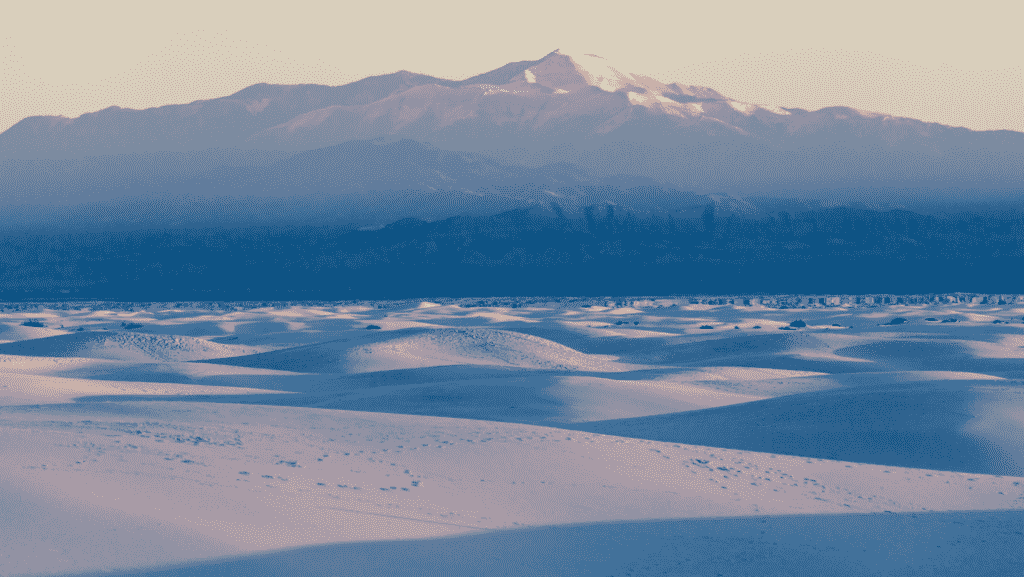
The fourth southwestern national park on our list to visit is White Sands National Park near Alamogordo, New Mexico.
Re-designated from a national monument to a national park in 2019, the park contains the largest gypsum dune-field in the world. Some of the dunes reach 60 feet high!
Visitors come from all over to explore the white sand dunes, making this national park the most visited National Park Service site in New Mexico.
GETTING THERE
White Sands National Park is just 3.5 hrs from Carlsbad Caverns to the west.
TIP: GPS is unreliable within the park. Be sure you have a backup navigation option such as a map with you.
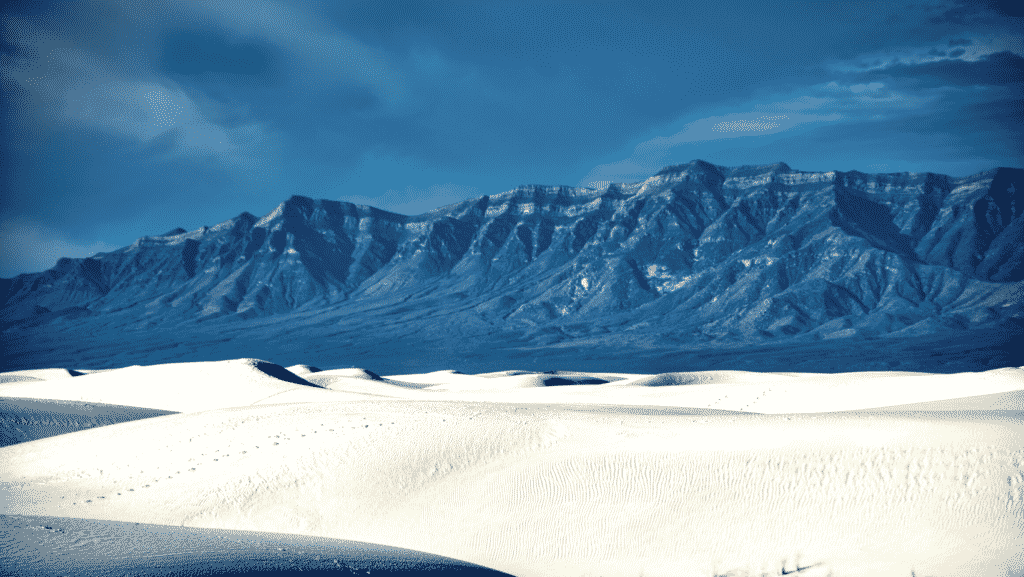
Where to stay
White Sands National Park has no accommodations inside the park. The closest accommodations can be found in Alamogordo 13 miles away, or Las Cruces 50 miles away.
The closest public campgrounds are Oliver Lee State Park (24 miles away), Aguirre Springs Recreation Area (39 miles), and the Lincoln National Forest (40 miles).
In Alamogordo, consider staying at the White Sands Motel which routinely receives high rankings by fellow travelers. There is also the Super 8 by Wyndham, and the Holiday Inn Express & Suites.
If B&Bs are more your style, consider Tavares Inn – a hacienda style place with a private family home atmosphere.
Fifty miles away in Las Cruces, check out the Best Western Mission Inn, Hilton Garden Inn Las Cruces, or the Home2 Suites by Hilton Las Cruces.
It’s worth noting as well that there are no restaurants in the park. You can however, find a small concession store in the White Sands Trading Gift Shop.
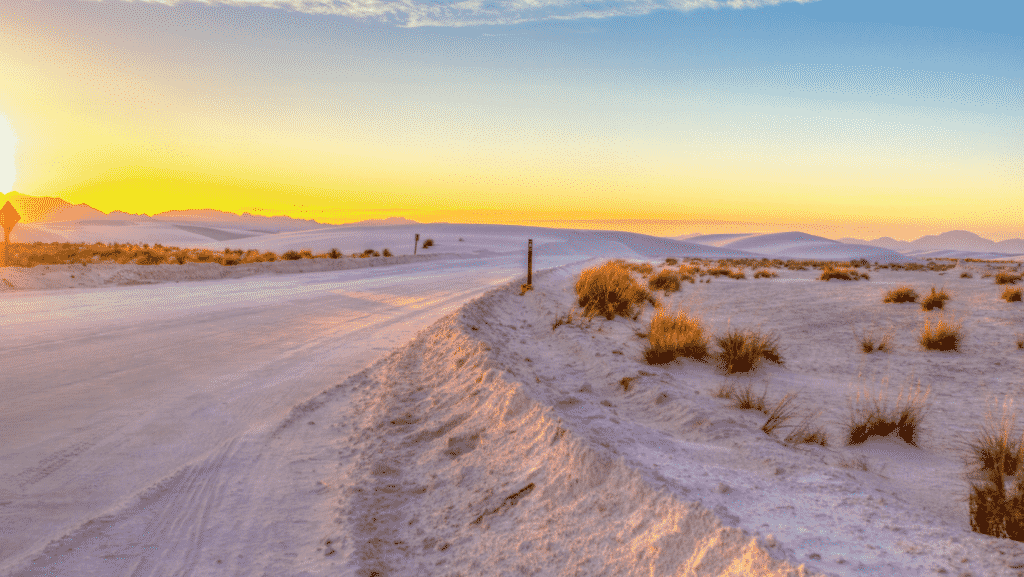
DAY 6
There are several ways to experience White Sands National Park.
Bicycling through the park is an excellent way to get up close and personal with the inhabitants and experience riding on the hard-packed sand roadways.
There’s also scenic drives, several great hiking trails, and of course…sledding.
Bicycling thru the dunes
Bicycles are permitted on park roads that are open to motorized vehicles. They are not permitted off-road or on any of the trails.
Dunes Drive is a popular route. The 16 miles roundtrip is a great experience, but be sure to bring water and snacks, sunscreen and sunglasses.
The roadway is best traveled on mountain bikes or sand cruisers with bigger tires. Due to the road conditions, bikes with street tires are not recommended.
Dunes scenic DRIVE
An alternative to biking the Scenic Dunes Drive is to enjoy it from the comfort of your vehicle. Drive time takes about 45 minutes and you travel into the heart of the dunes.
So, enjoy the journey: explore the dunes, take pictures.
There’s lots of things to see and do along the route.
There are outdoor exhibits, picnic areas, and hiking trails to explore.
The speed limit is 15-45mph throughout the park. Be sure to watch out for bicyclists!
Hiking
If you’re looking for a good hiking trail, here are two popular routes. Both are found along Dune Drive. (See map above for specific locations.)
Interdune Boardwalk
This trail is actually a boardwalk built above the sand, so strollers and wheelchairs will have no problem traveling along it.
The distance is less than ½ mi roundtrip with exhibits along the way.
It’s a great introduction to the dunes and the beautiful views of the Sacramento mountains.

Dune Life Nature Trail
The nature trail is a one mile loop, and takes about an hour. It’s rated a moderate trail for the climbing of two steep dunes. Most of trail is on soft sand.
Along the way you’ll see evidence of animals living in area -foxes, coyotes, badgers and various species of birds, reptiles and small rodents. Most animals in the park are nocturnal.
Park service requires you to be off the trail by sunset so keep timing in mind when planning your hike.
Bring lots of water! There is no water available near the trail and it’s 2.5 miles to the visitor center.
The weather in the park is a contrast of extremes. In the summer, temps reach over 100 degrees F and can drop down into the mid 60’s at night so make sure you bring appropriate clothing.
Hiking is not recommended once the temperature reaches over 85 degrees F and in the spring, winds can kick up causing white-out conditions.
So always be prepared and bring plenty of water with you.
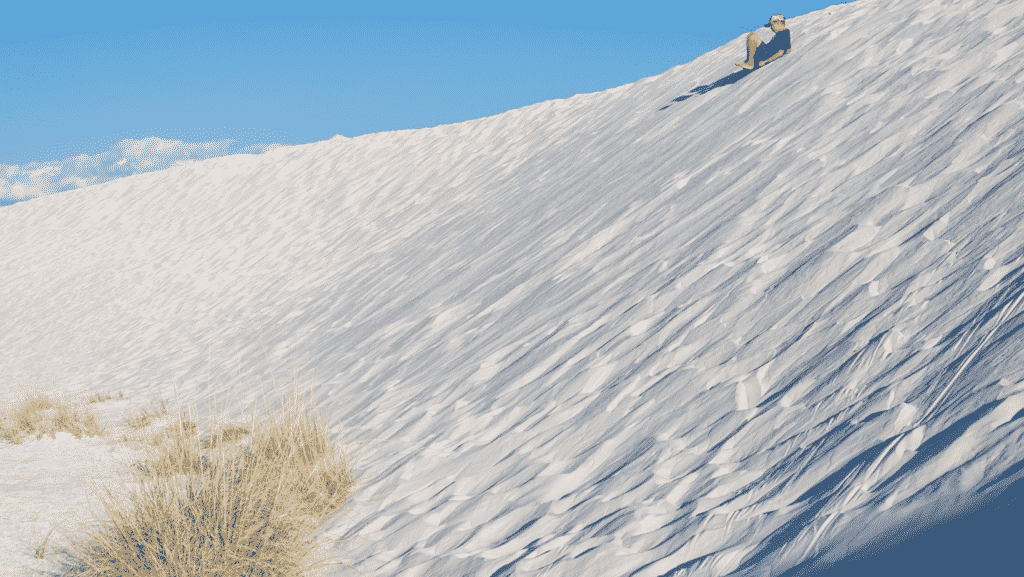
Sledding
Lastly we come to the most fun, and perhaps most unusual way, to experience White Sands National Park.
Sledding down the dunes!
Yep, just like snow sledding, but on sand!
You can purchase snow saucers at the gift shop, or bring your own.
Saucers work the best with the sand and since it’s a bit different sledding on sand than on snow, it may take a little practice.
But you’ll get the hang of it!
It’s really tons of fun -for kids and adults alike.
(Make sure you wax the bottom of the sled for best results.)
In the evening, consider a picnic dinner while you watch the sun set over the dunes. You just may be treated to a truly stunning display by Mother Nature.
CONCLUSION
Whether you have four days or four weeks, this itinerary can easily be condensed down or expanded to accommodate your travel time and activities.
Regardless of how much time you have or how much hiking, driving, and exploring you’re able to do, make sure you don’t bypass these four often over-looked southwestern national parks.
Each is unique and beautiful in their own way and are a tribute to this vast and dynamic country we call home.
So make sure you get out and visit these four stunning southwestern national parks now and embrace your inner dragonfly!

Did you enjoy this article? Read the conclusion of this 3-part series here: SoCal National Park Road Trip to Joshua Tree and Death Valley.
Have you been to these national parks? What was your favorite? Comment below! I’d love to hear from you!




Worked and lived in Big Bend N.P., my mom always called it my home. Still get a great longing to be back there. Friends and the beautiful park will always be some of my best memories.
I know the feeling Dana! There are several national parks that I feel a special affinity for and those are always full of great memories!
This Southwestern National Parks guide is incredibly helpful. You’ve really thought through everything you need to know before planning a trip. Thank you for this helpful resource. Saving this guide for later!
Thank you for that! I try to include information I know that I want or have found useful on our own travels. If you have any questions or want to know something more specific let me know. I’m always happy to help fellow travelers!